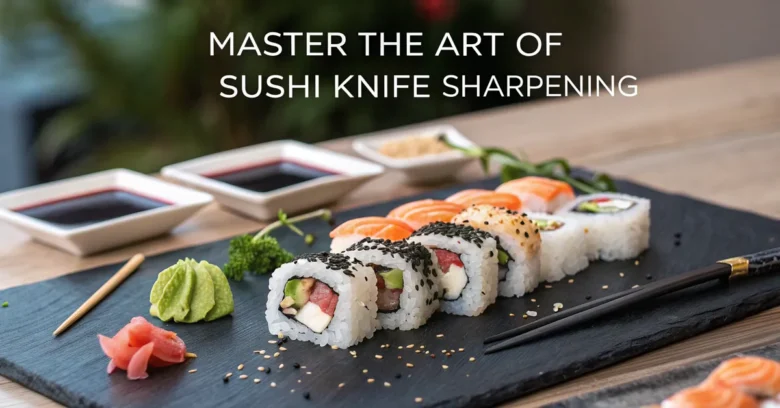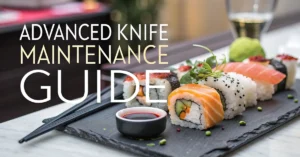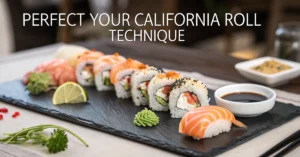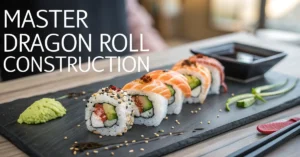Imagine crafting the perfect sushi roll. The rice is seasoned just right, the fish is impeccably fresh, and the nori snaps crisply. But what if your knife, the very tool that brings it all together, is dull? The clean, elegant slices become ragged tears, the delicate textures crushed. A sharp sushi knife isn’t just a preference; it’s an absolute necessity for achieving professional-level results. Many intermediate sushi chefs find themselves stuck, their knife skills plateauing not from a lack of practice, but from improper or inconsistent knife sharpening.
Sharpening, however, isn’t some mystical art reserved for master chefs. It’s a practical skill that, with the right knowledge and a bit of patience, you can master at home. This guide dives deep into the world of knife sharpening, providing you with the techniques and understanding needed to maintain your sushi knives in peak condition. You’ll learn about different sharpening methods, the importance of angle consistency, and how to troubleshoot common sharpening problems. Think of this as an investment, not just in your knives, but in the quality of your sushi and your overall culinary experience.
Why a Sharp Sushi Knife Matters
Beyond aesthetics, a sharp knife dramatically impacts both the flavor and texture of your sushi. Consider these key benefits:
-
Clean Cuts, Preserved Flavors: A dull knife tears at the delicate fibers of fish, bruising the flesh and releasing unwanted oils. This leads to a loss of natural sweetness and a muddied, less vibrant flavor profile. A sharp knife, on the other hand, slices cleanly, preserving the integrity of the fish and allowing its pure flavor to shine through.
-
Enhanced Texture: The texture of sushi is just as important as its taste. A dull knife crushes the ingredients, resulting in a mushy or uneven mouthfeel. A sharp knife allows you to create precise, even slices, resulting in a pleasingly firm and delicate texture that is a hallmark of high-quality sushi.
-
Safety First: It might seem counterintuitive, but a sharp knife is actually safer than a dull one. A dull knife requires more force to cut, increasing the risk of slipping and causing injury. A sharp knife glides through ingredients with minimal effort, giving you greater control and reducing the chance of accidents.
-
Reduced Food Waste: A sharp knife allows you to cut precise portions, minimizing waste. With a dull knife, you’re more likely to end up with uneven cuts and unusable scraps.
-
Increased Efficiency: Sharpening your knives will allow them to cut with ease, reducing the amount of time you spend preparing your dishes. The increased control from using sharp knives can help increase consistency, therefore reducing the number of mistakes you make.
Understanding Sushi Knife Steel: The Foundation of Sharpness
Before you even begin the knife sharpening process, it’s crucial to understand the type of steel your sushi knife is made from. Different steels have different hardness levels, which affects how easily they sharpen and how well they hold an edge.
-
Carbon Steel: This is the traditional material for Japanese knives, known for its exceptional sharpness and ease of sharpening. However, carbon steel is also prone to rusting and requires meticulous care to prevent corrosion.
-
Stainless Steel: Stainless steel knives are more resistant to rust and require less maintenance than carbon steel. However, they generally don’t get as sharp and can be more difficult to sharpen.
-
High-Carbon Stainless Steel: This is a hybrid material that combines the benefits of both carbon steel and stainless steel. These knives offer a good balance of sharpness, edge retention, and corrosion resistance.
The Rockwell Hardness Scale (HRC) is a common measure of steel hardness. Generally:
- HRC 56-58: Softer stainless steel, easier to sharpen but requires more frequent sharpening.
- HRC 59-61: Harder stainless steel or high-carbon stainless steel, holds an edge longer but can be more challenging to sharpen.
- HRC 62-65: Carbon steel, exceptionally sharp and holds an edge well, but requires careful maintenance.
Knowing the type of steel and its HRC rating will help you choose the appropriate knife sharpening method and abrasive materials.
Essential Tools for Knife Sharpening
To effectively sharpen your sushi knives, you’ll need a few essential tools:
-
Whetstones (Sharpening Stones): These are the primary tools for sharpening, consisting of abrasive particles bonded together. Whetstones come in various grits, each serving a different purpose.
- Coarse Grit (200-400): Used for repairing damaged edges or re-profiling a knife.
- Medium Grit (800-1200): Used for initial sharpening and removing scratches from the coarse stone.
- Fine Grit (3000-6000): Used for refining the edge and creating a razor-sharp finish.
- Ultra-Fine Grit (8000+): Used for polishing the edge to an extreme level of sharpness.
Whetstones can be made from natural stone or synthetic materials. Synthetic stones are generally more consistent in grit and less expensive.
-
Flattening Stone: Whetstones wear down over time, developing an uneven surface. A flattening stone is used to keep your whetstones flat, ensuring consistent knife sharpening.
-
Honing Steel: A honing steel (also sometimes incorrectly called a sharpening steel) does not actually sharpen your knife. It realigns the edge of the blade, which can become bent or misaligned with use. Honing should be done frequently, even daily, to maintain the knife’s sharpness between sharpenings.
-
Leather Strop: A leather strop is used to polish the edge of the blade after sharpening, removing any remaining burrs and creating a truly razor-sharp finish.
-
Water or Honing Oil: Water stones (the most popular kind for Japanese blades) require water to lubricate the surface and carry away metal particles. Oil stones use honing oil for the same purpose.
-
Angle Guide (Optional): An angle guide can help you maintain a consistent knife sharpening angle, especially when you’re first learning.
-
Clean Rags: You’ll need clean rags or paper towels to wipe the blade and stones during the sharpening process.
Setting Up Your Sharpening Station
Before you begin, create a dedicated sharpening station in a well-lit area. This will help you stay organized and focused.
-
Soak Your Whetstones: Most whetstones need to be soaked in water for a certain period of time before use. Follow the manufacturer’s instructions for soaking time. Some stones are “splash-and-go” stones that only require a brief splash of water.
-
Secure Your Stone: Place your whetstone on a non-slip surface, such as a damp towel or a stone holder. This will prevent the stone from moving during sharpening.
-
Prepare Your Water or Oil: Have a container of clean water or honing oil nearby to lubricate the stone as needed.
-
Gather Your Tools: Keep your honing steel, leather strop, and cleaning rags within easy reach.
Mastering the Knife Sharpening Technique: Step-by-Step
Now, let’s dive into the actual sharpening process. This method focuses on using whetstones, which is the preferred method for most sushi knives.
Step 1: Establishing the Angle
The most critical aspect of knife sharpening is maintaining a consistent angle. Sushi knives typically have a sharpening angle of 10-15 degrees.
-
Visualize the Angle: Imagine placing a coin (like a dime or nickel) next to the spine of the blade. This approximates the correct angle.
-
Position the Knife: Place the knife on the whetstone with the blade angled towards you.
-
Raise the Spine: Gently raise the spine of the knife until the blade is at the desired angle.
Step 2: The Sharpening Stroke
-
Apply Gentle Pressure: Apply light, even pressure to the blade as you push it across the whetstone. Focus on the area near the edge.
-
Maintain the Angle: Throughout the stroke, maintain the consistent angle you established in Step 1.
-
Full Blade Contact: Ensure the entire length of the blade makes contact with the stone during each stroke.
-
Overlapping Strokes: Overlap your strokes slightly to ensure even sharpening across the entire blade.
-
Alternate Sides: After several strokes on one side, flip the knife over and repeat the process on the other side. Maintaining an equal number of strokes on each side is important for creating a symmetrical edge.
Step 3: Working Through the Grits
-
Start with the Medium Grit: Begin with a medium-grit stone (800-1200) to establish the initial sharpness.
-
Remove Scratches: After sharpening on the medium grit, switch to a fine-grit stone (3000-6000) to remove the scratches left by the medium grit and further refine the edge.
-
Polish the Edge: For an even sharper finish, use an ultra-fine grit stone (8000+) to polish the edge to a mirror-like shine.
Step 4: Honing
-
Hold the Honing Steel: Hold the honing steel vertically with the tip resting on a stable surface.
-
Angle the Blade: Hold the knife at a slight angle to the honing steel (about 15-20 degrees).
-
Draw the Blade Down: Draw the blade down the honing steel, from heel to tip, maintaining the angle.
-
Alternate Sides: Repeat this process on the other side of the blade, alternating sides several times.
Step 5: Stropping
-
Prepare the Strop: If using a leather strop with compound, apply a small amount of the compound to the strop.
-
Angle the Blade: Hold the knife at a very slight angle to the strop.
-
Draw the Blade Backwards: Gently draw the blade backwards across the strop, from heel to tip, maintaining the angle. Important: Always draw the blade away from the edge to avoid cutting into the strop.
-
Alternate Sides: Repeat this process on the other side of the blade, alternating sides several times.
Step 6: Testing for Sharpness
There are several ways to test the sharpness of your knife:
-
Paper Test: Hold a sheet of paper vertically and try to slice through it with the knife. A sharp knife will slice cleanly through the paper without tearing.
-
Tomato Test: Try to slice a ripe tomato with the knife. A sharp knife will slice through the skin without requiring excessive pressure.
-
Hair Test: (Advanced) Carefully shave a few hairs from your arm with the knife. A truly razor-sharp knife will shave the hairs effortlessly.
Specific Considerations for Single-Bevel Sushi Knives (Deba, Yanagiba)
Many traditional sushi knives, such as the Deba (for butchering fish) and Yanagiba (for slicing fish), have a single-bevel edge. This means that only one side of the blade is sharpened at a steep angle, while the other side is flat or slightly concave. Sharpening single-bevel knives requires a slightly different technique.
-
Focus on the Bevel: The primary sharpening effort should be focused on the beveled side of the blade. Maintain the correct angle and use gentle pressure.
-
Minimal Work on the Flat Side: The flat side of the blade should only be lightly polished to remove any burr that forms during sharpening. Use very light pressure and a fine-grit stone.
-
Correcting the Shinogi Line: The shinogi is the line that separates the flat side from the beveled side. Maintaining a crisp, well-defined shinogi is crucial for the performance of a single-bevel knife.
Troubleshooting Common Knife Sharpening Problems
Even with careful technique, you may encounter some common knife sharpening problems:
-
Dull Edge After Sharpening: This could be due to several factors, including:
- Using too shallow of an angle.
- Not spending enough time on each grit.
- Using a worn-out whetstone.
- Not removing the burr properly.
-
Uneven Edge: This is often caused by inconsistent angle or pressure during sharpening. Practice maintaining a consistent angle and using even pressure.
-
Burr That Won’t Go Away: A burr is a thin, wire-like edge that forms during sharpening. It needs to be removed for the knife to be truly sharp. If the burr is persistent, try:
- Alternating sides more frequently.
- Using lighter pressure.
- Stropping on a leather strop.
-
Scratching the Blade: Using too coarse of a grit or applying too much pressure can scratch the blade. Start with a medium grit and gradually work your way to finer grits, using gentle pressure.
Maintaining Your Sharpened Edge
Once you’ve achieved a sharp edge, it’s important to maintain it with regular honing and stropping. Honing realigns the edge, while stropping polishes it. These simple steps can significantly extend the time between sharpenings.
-
Honing Frequency: Hone your knife before each use or at least daily.
-
Stropping Frequency: Strop your knife after each honing session or every few days.
Beyond Whetstones: Other Knife Sharpening Methods
While whetstones are the preferred method for most sushi knives, other options exist:
-
Electric Knife Sharpeners: These are convenient and easy to use, but they can be aggressive and remove too much metal. They are generally not recommended for high-quality sushi knives.
-
Pull-Through Sharpeners: These are also convenient, but they can damage the edge of the blade and are not as effective as whetstones. They are best used for quick touch-ups rather than full sharpenings.
-
Professional Sharpening Services: If you’re not comfortable sharpening your knives yourself, you can take them to a professional sharpening service. This is a good option for complex repairs or for knives that are severely damaged.
Safety Precautions
Knife sharpening involves working with sharp objects. Always take the following safety precautions:
- Focus and Attention: Sharpening requires concentration. Avoid distractions and take breaks when needed.
- Proper Grip: Use a firm, controlled grip on the knife handle.
- Finger Placement: Keep your fingers away from the edge of the blade.
- Cut-Resistant Gloves: Consider wearing cut-resistant gloves for added protection.
- First Aid Kit: Keep a well-stocked first aid kit nearby in case of accidents.
Is Knife Sharpening Worth Learning?
Mastering the art of knife sharpening is an investment that pays dividends in the quality of your sushi and the enjoyment of your culinary pursuits. While it may seem daunting at first, with practice and patience, you can develop the skills to maintain your sushi knives in peak condition. Not only will you be able to create cleaner, more flavorful sushi, but you’ll also gain a deeper appreciation for the tools and techniques that elevate cooking from a chore to an art form. By taking the time to learn this essential skill, you’re not just sharpening knives; you’re sharpening your craft.



